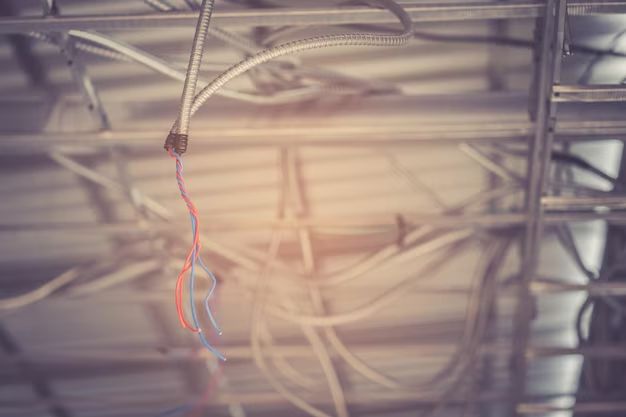There are a few reasons why a ceiling light fixture may have 4 wires coming out of the electrical box. Understanding the purpose of each wire is key to properly and safely installing a new light fixture.
Page Contents
The 4 Wires
Typically, the 4 wires you’ll see are:
- Black – The hot wire, carries electricity from the circuit breaker panel to the light
- White – The neutral wire, completes the circuit back to the panel
- Bare Copper – The ground wire, provides a safe path to ground for electricity
- Red – An additional hot wire, usually when the light is controlled by two separate light switches
Hot Wire
The black hot wire brings power from the circuit breaker panel to the light fixture. This wire is always hot, meaning it is energized with electricity at all times. For safety, always make sure the circuit breaker controlling the wire is shut off when working on an electrical project.
Neutral Wire
The white neutral wire provides a return path for electricity to complete the circuit. Current flows from the hot wire through the light bulb (or light fixture) and back through the neutral wire. The neutral wire is not energized like the hot wire, but when a light switch is on it becomes the return path to the circuit breaker panel. Always make sure any white neutral wires are properly connected and secured.
Ground Wire
The bare copper ground wire serves an important safety purpose. It provides a path to ground electricity in the event of a short circuit or other malfunction. This helps prevent electrical shocks and fire hazards. Properly connecting the ground wire to the light fixture ensures any errant electricity has an easy path to the ground rather than through a person’s body. Never try to power a light without connecting the ground wire.
Red Hot Wire
In some ceiling lights, you may find a fourth red wire coming from the electrical box. This red wire is most likely another hot wire that allows the light to be controlled by two separate light switches. One light switch controls the black hot, the other controls the red hot. This allows dual control of the light from two locations. The red wire needs to be properly connected to work correctly.
Understanding the Wires
Here is a quick summary of what each wire does:
| Wire Color | Purpose |
|---|---|
| Black | Hot wire – Carries electricity to light |
| White | Neutral wire – Returns electricity to panel |
| Bare Copper | Ground wire – Safe path to ground |
| Red | 2nd hot wire – For dual control |
Wiring a New Light Fixture
When wiring a new ceiling light fixture, follow these steps:
- Turn off electricity at the circuit breaker controlling the wires.
- Test wires with a non-contact voltage tester to ensure power is off.
- Disconnect and remove the old light fixture.
- Expose at least half an inch of copper wire using wire strippers.
- Connect the black hot wire to the black fixture wire.
- Connect the white neutral wire to the white fixture wire.
- Connect the ground wire to the green or bare copper fixture wire.
- Connect red wires if present for dual control.
- Secure wires with approved wire connectors.
- Tuck wires neatly into the electrical box.
- Mount the fixture base to the ceiling and install light bulbs.
- Test the light and enjoy your bright new light!
Getting Help with Electrical Wiring
Working with household electrical wiring can be dangerous if not done properly. If you are uncomfortable working with the wires, it is best to call a licensed electrician to install a new light fixture. An electrician will ensure proper wiring connections and compliance with electrical codes.
Below are some signs it may be time to call an electrician:
- You see corrosion or damaged wires
- Wires have inadequate insulation
- You have very old wiring in your home
- You don’t fully understand the wiring scheme
- You trip breakers or blow fuses frequently
Professional electricians have the knowledge, training, and tools to safely work on your home’s electrical system. They can inspect, troubleshoot, and fix any issues to keep your lights working properly for years to come.
FAQs about Ceiling Light Wiring
Why are there so many wires in light fixtures?
Modern electrical codes require light fixtures to have a hot wire, neutral wire, and ground wire. This ensures safe and reliable connections. Older lights may also have an additional hot wire for separate switch control.
Can I connect the wires myself?
Basic wiring of light fixtures like ceiling lights can be done DIY. Turn power off, follow diagrams, and make secure wire connections. More complex wiring should be done by electricians to ensure safety and function.
What are wire nuts?
Wire nuts are small plastic cone-shaped connectors used to join copper wires together. Just twist wires together tightly and screw on a properly-sized wire nut to secure the connection.
How do I know if I have grounded wiring?
Check for a bare copper ground wire in the electrical box. Modern wiring is typically grounded. Older homes may have outdated ungrounded wiring that should be inspected and possibly upgraded.
Why does my light fixture spark sometimes?
Occasional sparking can occur from loose wire connections. Turn off power and check all wiring nuts and connections are tight and secure. If sparking persists, consult an electrician immediately.
Conclusion
Understanding basic ceiling light wiring allows you to properly install fixtures and make repairs yourself. Always exercise caution when working with electrical wires. The hot, neutral, ground, and switch wires each serve important functions. Follow wiring diagrams closely. While wiring ceiling lights is doable DIY, it’s best to have a professional electrician handle any complex wiring jobs or unknown wiring situations in your home.
